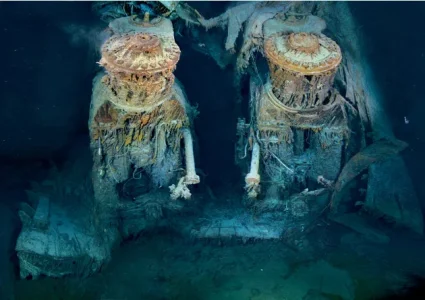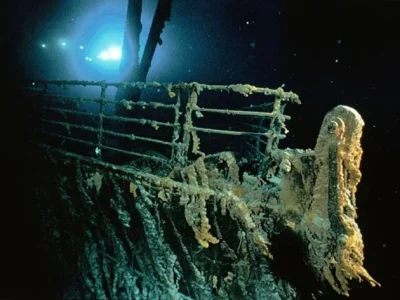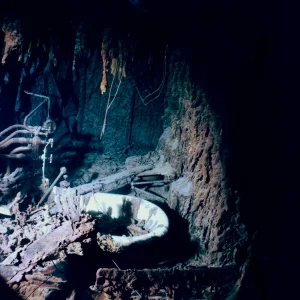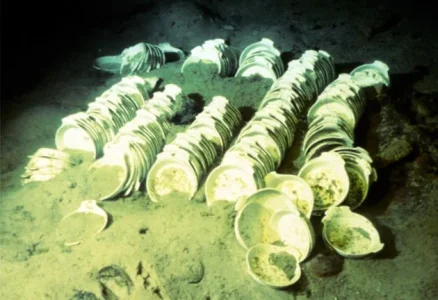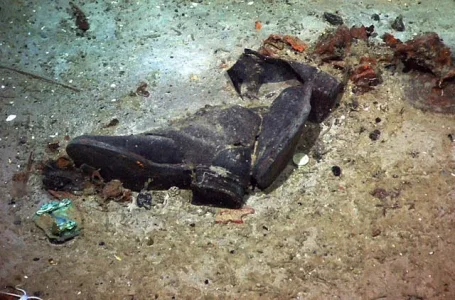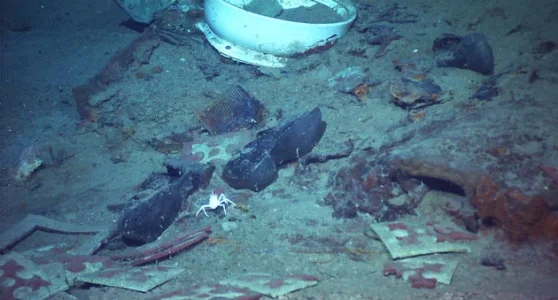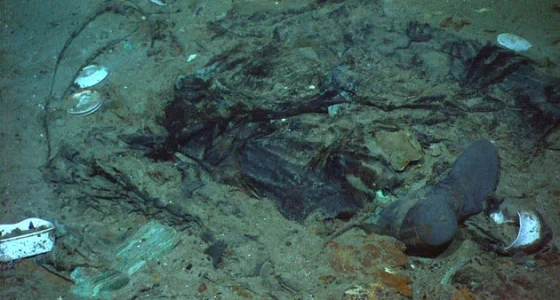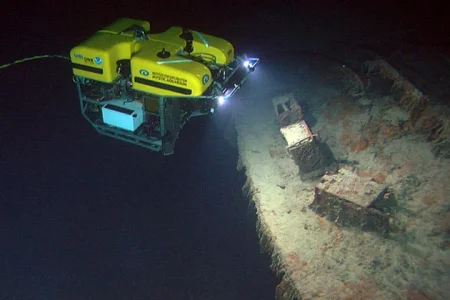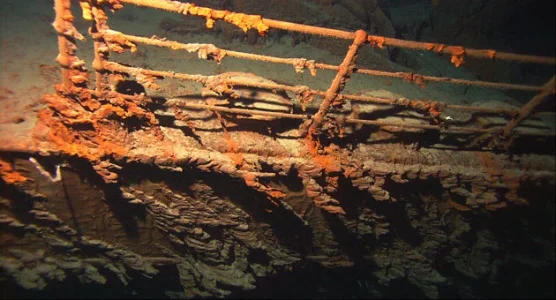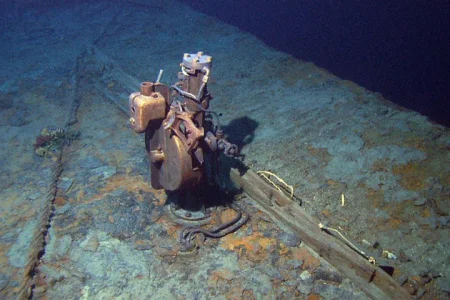You are using an out of date browser. It may not display this or other websites correctly.
You should upgrade or use an alternative browser.
You should upgrade or use an alternative browser.
Wreck of the Titanic
- Thread starter SKC
- Start date
More options
Who Replied?- Joined
- Jun 27, 2024
- Messages
- 2,611
- Likes
- 8,353
The wreck of RMS Titanic lies at a depth of about 12,500 feet (3,800 metres; 2,100 fathoms), about 370 nautical miles (690 kilometres) south-southeast off the coast of Newfoundland. It lies in two main pieces about 2,000 feet (600 m) apart. The bow is still recognisable with many preserved interiors, despite deterioration and damage sustained hitting the sea floor. In contrast, the stern is heavily damaged. A debris field around the wreck contains hundreds of thousands of items spilled from the ship as she sank. The bodies of the passengers and crew would also be distributed across the seabed, but have since been consumed by other organisms.
The Titanic sank in 1912, when she collided with an iceberg during her maiden voyage. Numerous expeditions unsuccessfully tried using sonar to map the seabed in the hope of finding the wreckage. In 1985, the wreck was finally located by a joint French–American expedition led by Jean-Louis Michel of IFREMER and Robert Ballard of the Woods Hole Oceanographic Institution, originally on a mission to find two nuclear cold war submarines
The Titanic sank in 1912, when she collided with an iceberg during her maiden voyage. Numerous expeditions unsuccessfully tried using sonar to map the seabed in the hope of finding the wreckage. In 1985, the wreck was finally located by a joint French–American expedition led by Jean-Louis Michel of IFREMER and Robert Ballard of the Woods Hole Oceanographic Institution, originally on a mission to find two nuclear cold war submarines
- Joined
- Jun 27, 2024
- Messages
- 2,611
- Likes
- 8,353

Two of Titanic's engines lie exposed in a gaping cross section of the stern. Draped in "rusticles"—orange stalactites created by iron-eating bacteria—these massive structures, four stories tall, once powered the largest moving man-made object on Earth.
COPYRIGHT© 2012 RMS TITANIC, INC; Produced by AVIL, Woods Hole Oceanographic Institute.
Attachments
Last edited:
- Joined
- Jun 27, 2024
- Messages
- 2,611
- Likes
- 8,353
- Joined
- Jun 27, 2024
- Messages
- 2,611
- Likes
- 8,353

A view of the steering motor on the bridge of the Titanic. Image copyright Emory Kristof/National Geographic.

With her rudder cleaving the sand and two propeller blades peeking from the murk, Titanic's mangled stern rests on the abyssal plain, 1,970 feet south of the more photographed bow. This optical mosaic combines 300 high-resolution images taken on a 2010 expedition.
COPYRIGHT© 2012 RMS TITANIC, INC; Produced by AIVL, Woods Hole Oceanographic Institute.
- Joined
- Jun 27, 2024
- Messages
- 2,611
- Likes
- 8,353

Ethereal views of Titanic's bow (modeled) offer a comprehensiveness of detail never seen before. COPYRIGHT© 2012 RMS TITANIC, INC; Produced by AIVL, Woods Hole Oceanographic Institute. Modeling by Stefan Fichtel.
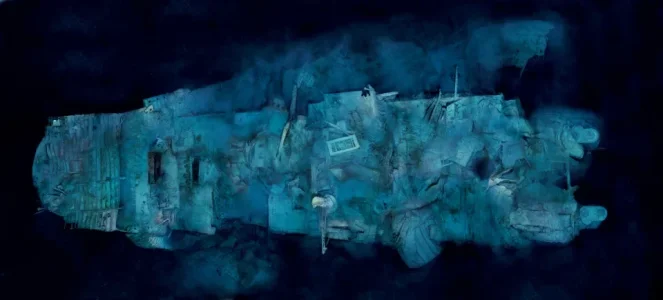
The first complete views of the legendary wreck Titanic's battered stern is captured overhead here. Making sense of this tangle of metal presents endless challenges to experts. Says one, "If you're going to interpret this stuff, you gotta love Picasso."
COPYRIGHT© 2012 RMS TITANIC, INC; Produced by AIVL, Woods Hole Oceanographic Institute.
- Joined
- Jun 27, 2024
- Messages
- 2,611
- Likes
- 8,353

Detached rusticles below port side anchor indicating that the rusticles pass through a cycle of growth, maturation and then fall away. This particular "crop" probably was in a five to ten year cycle. Image courtesy of Lori Johnston, RMS Titanic Expedition 2003, NOAA-OE.
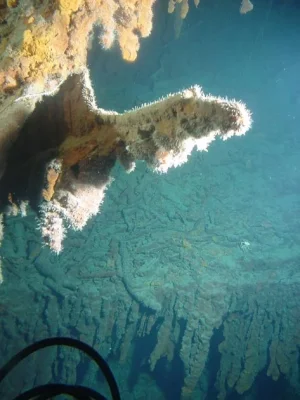
Rusticle hanging from the stern section of the RMS Titanic showing secondary growths during maturation. Image courtesy of Lori Johnston, RMS Titanic Expedition 2003, NOAA-OE.
- Joined
- Jun 27, 2024
- Messages
- 2,611
- Likes
- 8,353
Latest Replies
-
Indian Air Force: News & Discussions
- Spitfire IX
-
U.S China Cold War 2.0
- Sanglamorre
-
Idiotic Musings from the West
- Sanglamorre
-
Sinking State of Bangladesh: Idiotic Musings
- Indx TechStyle
-
US: News & Discussions
- shade2
-
Chit Chat
- sameer
-
Indian Special Forces
- Airborne22
-
Islamic Extremism in India : News , Discussions & Updates.
- Hindaviswarajya
-
Failed Terrorist State of Pakistan: Idiotic Musings
- vampyrbladez
-
Indian Economy
- sauntheninja


